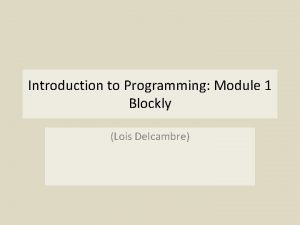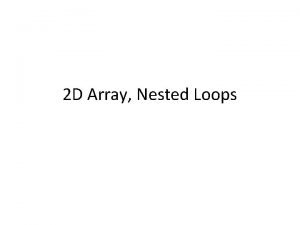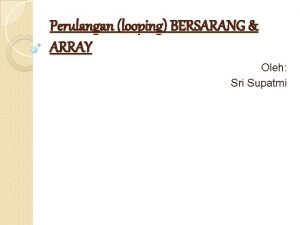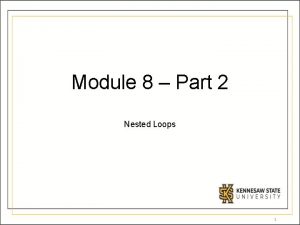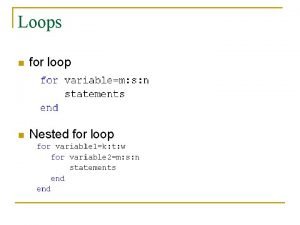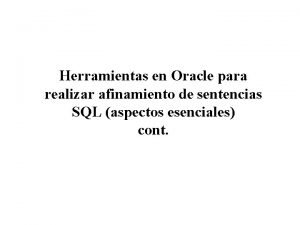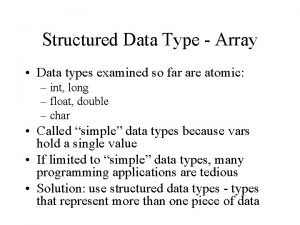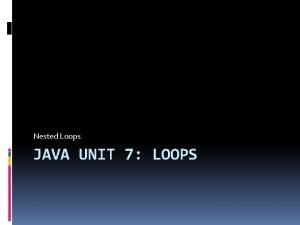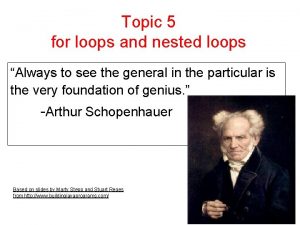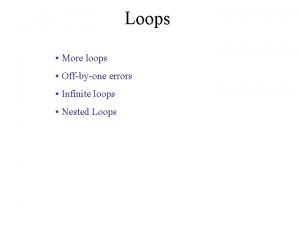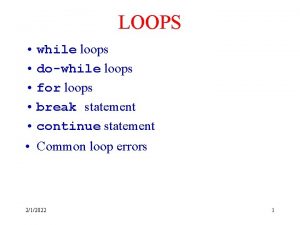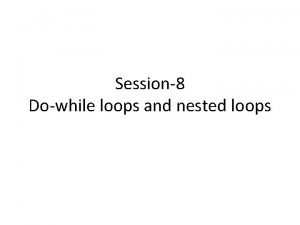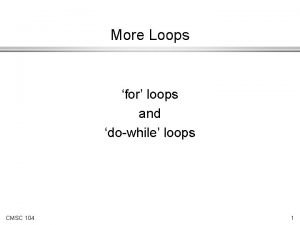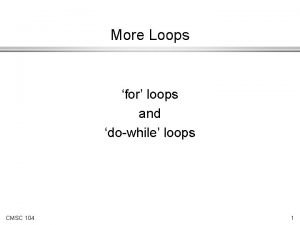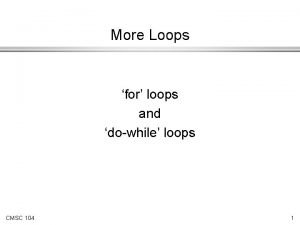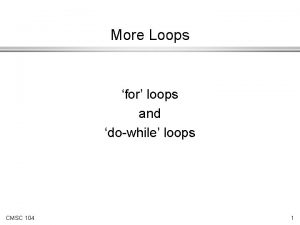Topic 5 for loops and nested loops Always







































- Slides: 39

Topic 5 for loops and nested loops “Always to see the general in the particular is the very foundation of genius. ” -Arthur Schopenhauer Based on slides by Marty Stepp and Stuart Reges from http: //www. buildingjavaprograms. com/ 1

Repetition with for loops 8 So far, repeating a statement is redundant: System. out. println("Mike says: "); System. out. println("Do Practice-It problems!"); System. out. println("It makes a HUGE difference. "); 8 Java's for loop statement performs a task many times. System. out. println("Mike says: "); for (int i = 1; i <= 5; i++) { // repeat 5 times System. out. println("Do Pratice-It problems!"); } System. out. println("It makes a HUGE difference. "); 2

for loop syntax for (<initialization>; <test>; <update>) { <statement>; . . . <statement>; } header body – Perform <initialization> once. – Repeat the following: • Check if the <test> is true. If not, stop. • Execute the <statement>s. • Perform the <update>. 3

Initialization for (int i = 1; i <= 5; i++) { System. out. println("Do Practice-It!"); } 8 Tells Java compiler what variable to use in the loop – Performed once as the loop begins – The variable is called a loop counter or loop control variable • can use any name, not just i • can start at any value, not just 1 4

Test for (int i = 1; i <= 5; i++) { System. out. println("Do Practice-It!"); } 8 Tests the loop counter variable against a limit – Uses comparison operators: < less than <= less than or equal to > greater than >= greater than or equal to == equality != not equals 5

Body for (int i = 1; i <= 5; i++) { System. out. println("Do Practice-It!"); } 8 If the test is true, the statements in the body of the loop execute in sequential order one time 8 The body of the loop is between the curly braces 8 If the body is one statement the curly braces are not required, but by convention we still add them 8 After the body of the loop completes the update statement is executed. 6

Update for(int i = 1; i <= 5; i++) { System. out. println("Do Practice-It!"); } 8 Perform update step – Generally adding one to loop control variable – Could be other operations such as subtracting one, multiplying 7

Aside: Increment and Decrement Operators shortcuts to increase or decrease a variable's value by 1 Shorthand <variable>++; <variable>--; int x = 2; x++; double gpa = 2. 5; gpa--; Equivalent longer version <variable> = <variable> + 1; <variable> = <variable> - 1; // x = x + 1; // x now stores 3 // gpa = gpa - 1; // gpa now stores 1. 5 8

Aside: Modify-and-assign operators shortcuts to modify a variable's value Shorthand Equivalent longer version <variable> += <variable> -= <variable> *= <variable> /= <variable> %= <variable> = <variable> = <exp>; <exp>; <variable> <variable> + * / % (<exp>); (<exp>); x += 3; // x = x + 3; gpa -= 0. 5; // gpa = gpa - 0. 5; number *= 2 + 1; // number = number * (2 + 1);

Clicker 1 8 What is output by the following code? int x = 2; int y = 5; x *= 3 + y + x; System. out. println(x + " " + y); A. B. C. D. E. 20 5 2 5 13 5 20 10 Something other than A - D 10

for loop is NOT a method 8 The for loop is a control structure – a syntactic structure that controls the execution of other statements. 8 Example: – “Shampoo hair. Rinse. Repeat. ” 11

Repetition over a range System. out. println("1 System. out. println("2 System. out. println("3 System. out. println("4 System. out. println("5 System. out. println("6 squared squared = = = " " " + + + 1 2 3 4 5 6 * * * 1); 2); 3); 4); 5); 6); – Intuition: "I want to print a line for each number from 1 to 6" 8 The for loop does exactly that! for (int i = 1; i <= 6; i++) { System. out. println(i + " squared = " + (i * i)); } – "For each integer i from 1 through 6, print. . . " 12

Loop walkthrough 1 2 4 for (int i = 1; i <= 4; i++) { 3 System. out. println(i + " squared = " + (i * i)); } 5 System. out. println("Whoo!"); 1 Output: 1 squared 2 squared 3 squared 4 squared Whoo! 2 = = 1 4 9 16 3 4 5 13

Simple Loop Example 8 Write a program to calculate and print out the values of N! from 1 to 50 using a for loop 80! = 1 81! = 1 * 0! = 1 * 1 = 1 82! = 2 * 1 * 1 = 2 83! = 3 * 2 * 1 = 6 84! = 4 * 3 * 2 * 1 = 24 14

Multi-line loop body System. out. println("+----+"); for (int i = 1; i <= 3; i++) { System. out. println("\ /"); System. out. println("/ \"); } System. out. println("+----+"); Output: +----+ / / +----+ 15

Expressions for counter int high. Temp = 5; for (int i = -3; i <= high. Temp / 2; i++) { System. out. println(i * 1. 8 + 32); } – This computes the Fahrenheit equivalents for -3 degrees Celsius to 2 degrees Celsius. Output: 26. 6 28. 4 30. 2 32. 0 33. 8 16 35. 6

System. out. print 8 Prints without moving to a new line – allows you to print partial messages on the same line int highest. Temp = 5; for (int i = -3; i <= highest. Temp / 2; i++) { System. out. print((i * 1. 8 + 32) + " "); } • Output: 26. 6 28. 4 • Concatenate " 30. 2 32. 0 33. 8 35. 6 " to separate the numbers 17

Clicker 2 8 How many asterisks are output by the following code? for(int i = -2; i <= 13; i++) { System. out. print("*"); System. out. print("**"); } A. 0 D. 48 B. 15 E. 68 C. 45 18

Counting down 8 The <update> can use -- to make the loop count down. – The <test> must say > instead of < (or logic error) System. out. print("T-minus "); for (int i = 10; i >= 1; i--) { System. out. print(i + ", "); } System. out. println("blastoff!"); System. out. println("The end. "); Output: T-minus 10, 9, 8, 7, 6, 5, 4, 3, 2, 1, blastoff! 19 The end.

Practice Problem 8 Newton's method for approximating square roots adapted from the Dr. Math website The goal is to find the square root of a number. Let's call it num 1. Choose a rough approximation of the square root of num, call it approx. How to choose? 2. Divide num by approx and then average the quotient with approx, in other words we want to evaluate the expression ((num/approx) + approx) / 2 3. How close are we? In programming we would store the result of the expression back into the variable approx. 4. How do you know if you have the right answer? 20

Sample of Newton's Method num 12 12 12 approx 6 4 3. 5 3. 4642857 3. 46410162 ((num/approx)+approx)/2 approx*approx (12 / 6 + 6) / 2 = 4 16 (12 / 4 + 4) / 2 = 3. 5 12. 25 (12 / 3. 5 + 3. 5) / 2 = 3. 4642857… 12. 0012. . = 3. 46410162… 12. 00000003 = 3. 46410161… 11. 99999 3. 4641016151377544 after 5 steps 3. 4641016151377545870548926830117 (from calculator) 21

Nested loops reading: 2. 3 22

Nested loops 8 nested loop: A loop placed inside another loop. for (int i = 1; i <= 5; i++) { for (int j = 1; j <= 10; j++) { System. out. print("*"); } System. out. println(); // to end the line } 8 Output: ********** ***** 8 The outer loop repeats 5 times; the inner one 10 times. – "sets and reps" exercise analogy 23

Nested for loop exercise 8 What is the output of the following nested for loops? for (int i = 1; i <= 5; i++) { for (int j = 1; j <= i; j++) { System. out. print("*"); } System. out. println(); } 8 Output: * ** ***** 24

Nested for loop exercise 8 What is the output of the following nested for loops? for (int i = 1; i <= 5; i++) { for (int j = 1; j <= i; j++) { System. out. print(i); } System. out. println(); } 8 Output: 1 22 333 4444 55555 25

Clicker 3 8 What is output by the following code? int total = 0; for(int i = 1; i <= 4; i++) { for(int j = 1; j <= i; j++) { total += i; } } System. out. println(total); A. 4 B. 10 C. 16 D. 24 E. 30 26

Common errors 8 Both of the following sets of code produce infinite loops: for (int i = 1; i <= 5; i++) { for (int j = 1; i <= 10; j++) { System. out. print("*"); } System. out. println(); } for (int i = 1; i <= 5; i++) { for (int j = 1; j <= 10; i++) { System. out. print("*"); } System. out. println(); } 27

Complex output 8 Write a nested for loop to produce the following output. inner loop (repeated characters on each line) . . 1. . . 2. . 3. 4 5 outer loop (loops 5 times because there are 5 lines) 8 We must build multiple complex lines of output using: – an outer "vertical" loop for each of the lines – inner "horizontal" loop(s) for the patterns within each line 28

Outer and inner loop 8 First write the outer loop, from 1 to the number of lines. for (int line = 1; line <= 5; line++) {. . . } 8 Now look at the line contents. Each line has a pattern: – some dots (0 dots on the last line), then a number . . 1. . . 2. . 3. 4 5 29 – Observation: the number of dots is related to the line number.

Mapping loops to numbers for (int count = 1; count <= 5; count++) { System. out. print(. . . ); } – What statement in the body would cause the loop to print: 4 7 10 13 16 for (int count = 1; count <= 5; count++) { System. out. print(3 * count + 1 + " "); } 30

Loop tables 8 What statement in the body would cause the loop to print: 2 7 12 17 22 8 To see patterns, make a table of count and the numbers. – Each time count goes up by 1, the number should go up by 5. – But count * 5 is too great by 3, so we subtract 3. count number to print 5 * count - 3 1 2 5 2 2 7 10 7 3 12 15 12 4 17 20 17 5 22 25 22 31

Loop tables question 8 What statement in the body would cause the loop to print: 17 13 9 5 1 • Let's create the loop table together. – Each time count goes up 1, the number printed should. . . – But this multiple is off by a margin of. . . count number to print -4 * count + 21 1 17 -4 17 2 13 -8 13 3 9 -12 9 4 5 -16 5 5 1 -20 1 32

Another view: Slope-intercept 8 The next three slides present the mathematical basis for the loop tables. count (x) number to print (y) 1 2 2 7 3 12 4 17 5 22 33

Another view: Slope-intercept 8 Caution: This is algebra, not assignment! 8 Recall: slope-intercept form (y = mx + b) 8 Slope is defined as “rise over run” (i. e. rise / run). Since the “run” is always 1 (we increment along x by 1), we just need to look at the “rise”. The rise is the difference between the y values. Thus, the slope (m) is the difference between y values; in this case, it is +5. 8 To compute the y-intercept (b), plug in the value of y at x = 1 and solve for b. In this case, y = 2. y = m * x + b 2 = 5 * 1 + b Then b = -3 8 So the equation is y = m * x + b y = 5 * x – 3 y = 5 * count - 3 count (x) number to print (y) 1 2 2 7 3 12 4 17 5 22 34

Another view: Slope-intercept 8 Algebraically, if we always take the value of y at x = 1, then we can solve for b as follows: y = m * x + b y 1 = m * 1 + b y 1 = m + b b = y 1 – m 8 In other words, to get the y-intercept, just subtract the slope from the first y value (b = 2 – 5 = -3) – This gets us the equation y = m * x + b y = 5 * x – 3 y = 5 * count – 3 (which is exactly the equation from the previous slides) 35

Nested for loop exercise 8 Make a table to represent any patterns on each line. . . 1. . . 2. . 3. 4 5 line # of dots -1 * line + 5 1 4 -1 4 2 3 -2 3 3 2 -3 2 4 1 -4 1 5 0 -5 0 8 To print a character multiple times, use a for loop. for (int j = 1; j <= 4; j++) { System. out. print(". "); } // 4 dots 36

Nested for loop solution 8 Answer: for (int line = 1; line <= 5; line++) { for (int j = 1; j <= (-1 * line + 5); j++) { System. out. print(". "); } System. out. println(line); } 8 Output: . . 1. . . 2. . 3. 4 5 37

Nested for loop exercise 8 What is the output of the following nested for loops? for (int line = 1; line <= 5; line++) { for (int j = 1; j <= (-1 * line + 5); j++) { System. out. print(". "); } for (int k = 1; k <= line; k++) { System. out. print(line); } System. out. println(); } 8 Answer: . . 1. . . 22. . 333. 4444 38 55555

Nested for loop exercise 8 Modify the previous code to produce this output: . . 1. . . 2. . . 3. . . 4. . . 5. . for (int line = 1; line <= 5; line++) { for (int j = 1; j <= (-1 * line + 5); j++) { System. out. print(". "); } System. out. print(line); for (int j = 1; j <= (line - 1); j++) { System. out. print(". "); } System. out. println(); 39 }
 Nested loop matlab
Nested loop matlab Programming puzzle
Programming puzzle Perulangan python
Perulangan python Nested loops python
Nested loops python Is nested loops bad
Is nested loops bad Nested loop complexity
Nested loop complexity Pseudocode nested loop example
Pseudocode nested loop example N nested for loops
N nested for loops Nested loops oracle
Nested loops oracle For loop space complexity
For loop space complexity Nested loops storytelling
Nested loops storytelling Structured text array
Structured text array Nested loops java
Nested loops java Painted paragraph strategy
Painted paragraph strategy Narrowed down topic
Narrowed down topic Always low prices always
Always low prices always Kontinuitetshantering
Kontinuitetshantering Typiska novell drag
Typiska novell drag Nationell inriktning för artificiell intelligens
Nationell inriktning för artificiell intelligens Vad står k.r.å.k.a.n för
Vad står k.r.å.k.a.n för Varför kallas perioden 1918-1939 för mellankrigstiden?
Varför kallas perioden 1918-1939 för mellankrigstiden? En lathund för arbete med kontinuitetshantering
En lathund för arbete med kontinuitetshantering Underlag för särskild löneskatt på pensionskostnader
Underlag för särskild löneskatt på pensionskostnader Personlig tidbok för yrkesförare
Personlig tidbok för yrkesförare Anatomi organ reproduksi
Anatomi organ reproduksi Densitet vatten
Densitet vatten Datorkunskap för nybörjare
Datorkunskap för nybörjare Stig kerman
Stig kerman Att skriva debattartikel
Att skriva debattartikel Delegerande ledarskap
Delegerande ledarskap Nyckelkompetenser för livslångt lärande
Nyckelkompetenser för livslångt lärande Påbyggnader för flakfordon
Påbyggnader för flakfordon Arkimedes princip formel
Arkimedes princip formel Offentlig förvaltning
Offentlig förvaltning I gullregnens månad
I gullregnens månad Presentera för publik crossboss
Presentera för publik crossboss Argument för teckenspråk som minoritetsspråk
Argument för teckenspråk som minoritetsspråk Vem räknas som jude
Vem räknas som jude Treserva lathund
Treserva lathund Mjälthilus
Mjälthilus

